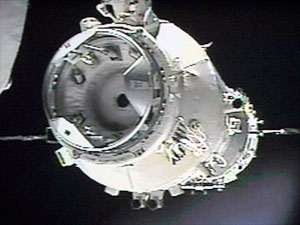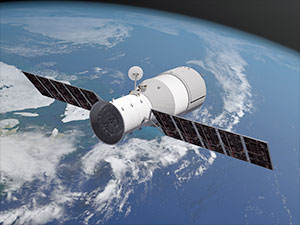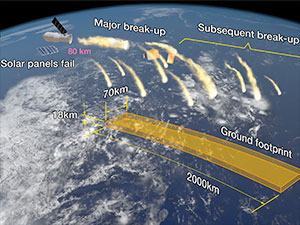April 1, 2018 — China's first prototype space station has fallen back to Earth, six and a half years after it was launched.
The space lab Tiangong-1 (translated from Chinese "Celestial Palace-1") made an uncontrolled re-entry into the atmosphere on Sunday (April 1), breaking apart in a fiery plunge over the southern Pacific Ocean at about 8:16 p.m. EDT (0016 GMT on April 2), according to U.S. Strategic Command's Joint Force Space Component Command.
"The re-entry falling area [was] located in the central region of South Pacific. Most of the devices were ablated during the re-entry process," stated the China Manned Space Agency (CMSA) in a notice posted to its website.
Given the spacecraft's size and mass, some parts of the 34-foot-long (10.4 meter) space station were predicted to make it the ground, or in this case, splash down into the ocean, but if that occurred is unknown.
Tiangong-1 hosted two crews of three astronauts (or "taikonauts") each, including China's first woman in space, for two-week missions in 2012 and 2013. It, and its follow-on Tiangong-2, in orbit since 2016, were designed as prototypes for a multi-module, larger space station, which China plans to begin deploying this year.
What goes up...
Tiangong-1 wasn't supposed to end this way.
Launched Sept. 29, 2011 by a Long March 2F/G rocket from the Jiuquan Satellite Launch Center in China's Gobi desert, Tiangong-1 was in active operation for two years. In addition to serving as a platform for scientific experiments, it became the target for the uncrewed Shenzhou 8 spacecraft to achieve China's first docking on Nov. 3, 2011.
The Shenzhou 9 crew of Jing Haipeng, Liu Wang and Liu Yang (the latter, China's first female taikonaut) were the first to come aboard Tiangong-1 on June 18, 2012 and resided on the space laboratory for 11 days. Their visit was followed up a year later by Nie Haisheng, Zhang Xiaoguang and Wang Yaping aboard Shenzhou 10 for a 13-day stay beginning on June 13, 2013.
China's Manned Space Engineering Office continued to operate Tiangong-1 as an uncrewed platform for an extended two-year mission. The original plan was then to use the station's two orbital maneuvering engines to direct a controlled re-entry over a large and remote region of the south Pacific Ocean.
In March 2016 though, China announced that Tiangong-1 had ceased responding to commands from the ground. No longer capable of being directed back to Earth, the wait began for atmospheric drag and gravity to take its toll.
...must come down
As uncontrolled re-entering spacecraft go, Tiangong-1 ranked at the bottom of the top 50 by mass (Tiangong-1 weighted 8.5 tons fully-fueled at launch; a final mass was not released by the Chinese).
Other uncontrolled re-entries by large spacecraft have included Russia's Phobos-Grunt probe in January 2012; the German Roentgen satellite in October 2011; and NASA's Upper Atmosphere Research Satellite in September 2011. Most recently, a Russian Progress spacecraft fell back to Earth in May 2015 after tumbling out of control on it way to resupply the International Space Station.
All four spacecraft fell over bodies of water and no pieces were recovered.
The most massive spacecraft to make the "natural" plunge to Earth was the 74-ton Skyab, the United States' first space station, in July 1979. It dropped pieces over the Australian outback.
Under the Outer Space Treaty of 1967, party nations retain title to their spacecraft, regardless if they are in orbit or in pieces on the ground (or sunken on the ocean floor), until ownerships is explicitly released. The treaty also holds countries liable for any damage their returning spacecraft may cause.
In 1979, after completing an assessment of the debris, NASA released its claim on the Skylab debris, which Australians and others collected and some later sold as souvenirs.
China did not make its intentions known with regards to Tiangong-1 debris, should any later wash up on a shore or be recovered at sea. |
|

Tiangong-1, as seen from Shenzhou 9 in September 2016. (CMSE)

Artist's rendition of Tiangong-1 in orbit. (Aerospace Corporation)

Uncontrolled re-entry events overview. (Aerospace Corporation)

Shenzhou 9 crew aboard Tinagong-1 in September 2016. (CCTV) |
